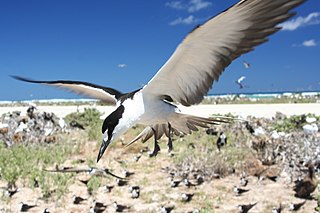
Terns are seabirds in the family Laridae, subfamily Sterninae, that have a worldwide distribution and are normally found near the sea, rivers, or wetlands. Terns are treated in eleven genera in a subgroup of the family Laridae, which also includes several genera of gulls and the skimmers (Rynchops). They are slender, lightly built birds with long, forked tails, narrow wings, long bills, and relatively short legs. Most species are pale grey above and white below with a contrasting black cap to the head, but the marsh terns, the black-bellied tern, the Inca tern, and some noddies have dark body plumage for at least part of the year. The sexes are identical in appearance, but young birds are readily distinguishable from adults. Terns have a non-breeding plumage, which usually involves a white forehead and much-reduced black cap.

Laridae is a family of seabirds in the order Charadriiformes that includes the gulls, terns, noddies, skimmers, and kittiwakes. It includes around 100 species arranged into 22 genera. They are an adaptable group of mostly aerial birds found worldwide.

The little tern is a seabird of the family Laridae. It was first described by the German naturalist Peter Simon Pallas in 1764 and given the binomial name Sterna albifrons. It was moved to the genus Sternula when the genus Sterna was restricted to the larger typical terns. The genus name Sternula is a diminutive of Sterna, 'tern', while the specific name albifrons is from Latin albus, 'white', and frons, 'forehead'.

The black tern is a small tern generally found in or near inland water that breeds in Europe, Western Asia and North America. In winter the birds migrate to coastal areas of Africa and South America.

The white-winged tern, or white-winged black tern, is a species of tern in the family Laridae. It is a small species generally found in or near bodies of fresh water across much of the world, including Europe, Africa, Asia, and Australia. The genus name is from Ancient Greek khelidonios, "swallow-like", from khelidon, "swallow".

The Sandwich tern is a tern in the family Laridae. It is very closely related to the lesser crested tern, Chinese crested tern, Cabot's tern, and elegant tern and has been known to interbreed with both elegant and lesser crested. It breeds in the Palearctic from Europe to the Caspian Sea and winters in South Africa, India, and Sri Lanka.

The roseate tern is a species of tern in the family Laridae. The genus name Sterna is derived from Old English "stearn", "tern", and the specific dougallii refers to Scottish physician and collector Dr Peter McDougall (1777–1814). "Roseate" refers to the bird's pink breast in breeding plumage.

The whiskered tern is a tern in the family Laridae. The genus name is from Ancient Greek khelidonios, "swallow-like", from khelidon, "swallow". The specific hybridus is Latin for hybrid; Peter Simon Pallas thought it might be a hybrid of white-winged black tern and common tern, writing "Sterna fissipes [Chlidonias leucopterus] et Hirundine [Sterna hirundo] natam".

The gull-billed tern, formerly Sterna nilotica, is a tern in the family Laridae. It is widely distributed and breeds in scattered localities in Europe, Asia, northwest Africa, and the Americas. The Australian gull-billed tern was previously considered a subspecies.

The royal tern is a tern in the family Laridae. The species is endemic to the Americas, though vagrants have been identified in Europe.

Forster's tern is a tern in the family Laridae. The genus name Sterna is derived from Old English "stearn", "tern", and forsteri commemorates the naturalist Johann Reinhold Forster.

Sterna is a genus of terns in the bird family Laridae. The genus used to encompass most "white" terns indiscriminately, but mtDNA sequence comparisons have recently determined that this arrangement is paraphyletic. It is now restricted to the typical medium-sized white terns occurring near-globally in coastal regions.

Dinopium is a genus of birds in the woodpecker family Picidae. The species are found in South and Southeast Asia.

The black-bellied tern is a tern found near large rivers in the Indian subcontinent, its range extending from Pakistan, Nepal and India to Myanmar. It has become very scarce in the eastern part of its range and the International Union for Conservation of Nature has assessed its conservation status as being endangered.

Onychoprion, the "brown-backed terns", is a genus of seabirds in the family Laridae. The genus name is from Ancient Greek onux, "claw" or "nail", and prion, "saw".

Thalasseus, the crested terns, is a genus of eight species of terns in the family Laridae.

The black-fronted tern, also known as sea martin, ploughboy, inland tern, riverbed tern or tarapiroe, is a small tern generally found in or near bodies of fresh water in New Zealand, where it forages for freshwater fish, arthropods and worms. It has a predominantly grey plumage. Restricted to breeding in the eastern regions of the South Island, it is declining and threatened by introduced mammals and birds. It is rated as endangered on the International Union for Conservation of Nature (IUCN)'s Red List of Threatened Species.

The large-billed tern is a species of tern in the family Laridae. It is placed the monotypic genus Phaetusa. It is found in most of South America. It has occurred as a vagrant in Aruba, Bermuda, Cuba, Panama and the United States. Its natural habitats are rivers and freshwater lakes.

The blue noddy or hinaokū or manuohina is a seabird in the family Laridae. It is also known as the blue-grey noddy.

Sternula is a genus of small white terns. It is often subsumed into the larger genus Sterna, although the most recent changes to the AOU checklist considers it a separate genus. The genus name is a diminutive of Sterna, "tern".





























